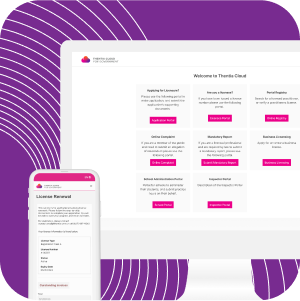Types and functions of regulators
Regulators are defined by their function. While most will endeavor to carry out a full range of regulatory functions, many agencies find themselves focused mostly on one or two types of regulation in practice. Some regulators, like the Ontario College of Trades, focus on licensing, which can include collecting fees, issuing permits, and maintaining a public registry. Others, like the Canadian Law Societies, may handle licensing as well as complaints, investigations, and prosecutions entirely in-house.
There is no hard and fast rule for determining which regulators perform which types of regulation. In general, though, regulators who are more “license-focused” will find themselves focusing upon restrictive regulation (i.e., setting licensing standards and processing applications) and transparent regulation (i.e., maintaining a searchable public registry of licensed professionals). A “full-service” regulator, on the other hand, will equally prioritize reactive regulation as well by investigating and prosecuting professional misconduct on its own.
Many regulators fall somewhere in between being “license-focused” and “full-service.” Almost all American Bar Associations, for example, do not prosecute in-house. Though they may conduct a significant portion of investigations in-house, they ultimately hand their prosecutions over to the state – usually the Appellate Division of the State Supreme Court, where a committee completes its own investigation and makes a determination.
How do regulators measure success?
One of the fundamental challenges of regulation is measuring efficacy. If regulation exists to protect the public interest by making sure citizens are not exploited or mistreated by professionals, how can a regulator measure its ability to fulfill this purpose? For example, if a regulator publishes content that helps licensees not commit a certain infraction, how do we measure what never happened?
On the other hand, if a regulator allows the public to easily find and file a complaint online, and as a result, complaints increase, is the increase a sign that the regulator is failing or succeeding? While no one metric can accurately depict how a regulator is performing, it may be important to look at certain metrics in line with the method of regulation the regulator is using.
As we covered in our ongoing series of blog posts concerning regulatory excellence, many government leaders around the world have made their own attempts to determine what “regulatory excellence” is and what regulators can do to meet higher standards in their work. For example, in 2015, Penn Program on Regulation (PPR) director Cary Coglianese published a report called Listening, Learning, and Leading: A Framework for Regulatory Excellence, which proposes a model of regulatory excellence that can be followed by government leaders everywhere.
The report posits that the most successful regulators are seen to exhibit transparency, fairness, consistency, flexibility, accountability, adaptiveness, and trustworthiness, among other traits. Coglianese takes this analysis further by establishing three core standards of regulatory excellence across most fields: utmost integrity, empathetic engagement, and stellar competence. From these core traits, the report derives nine basic tenets that summarize the aspirations of effective regulators:
- Fidelity to law.
- Respect for democracy.
- Commitment to public interest.
- Even-handedness.
- Listening.
- Responsiveness.
- Analytical capability.
- Instrumental capacity.
- High performance.
As more regulators move away from paper-based processes and toward integrated electronic databases, the amount of regulatory data at their disposal continues to amass. It is possible that by analyzing this data (evaluating the number of complaints levied over time, for example) regulators might find themselves better able to determine how well they are serving their public interest. The fact remains, however, that they may never be able to measure their efficacy in any exact terms.
Recap: the goals and principles of regulation
Professional regulation is either directly or indirectly relevant to anybody who participates in a country’s economy. At its best, it is a dynamic, ever-evolving practice that keeps the public safe in a fast-changing world. Regulators deploy restrictive, reactive, proactive, and transparent measures in an effort to ensure thorough protection of citizens who interact with their industries. While it’s challenging to gauge the “success” of these measures, regulators can work to ensure they are doing the best job possible in their endeavor to serve the public by remaining attentive, accessible, and up to date on industry trends.
Learn more about the fundamental goals and principles of regulation in our first informative whitepaper, “The Goals of Professional Regulation: How Regulators Act to Protect the Public.”













